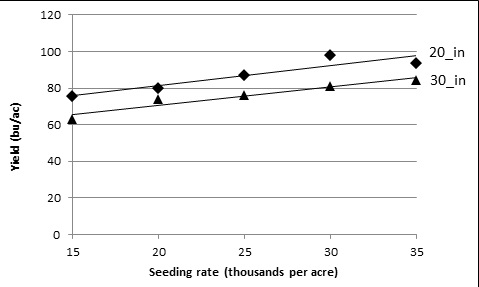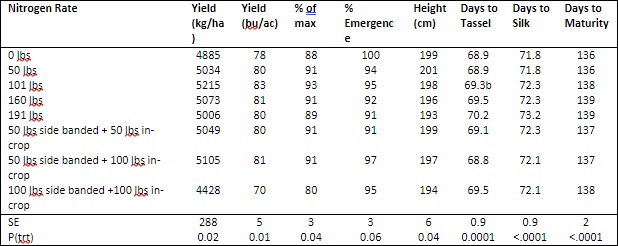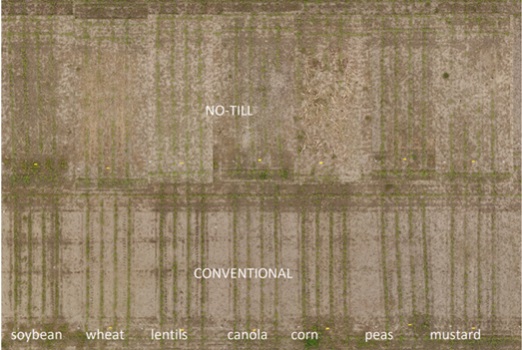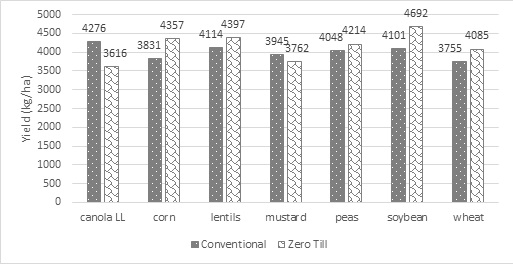Project AbstractTo take advantage of a huge production and profit opportunity for Alberta farmers, Farming Smarter looked for the best ways to grow grain corn in Alberta's climate and soils. There are new short season, early maturing grain corn varieties for Alberta and Saskatchewan.This 3-year study conducted trials under two field moisture conditions dryland (DL) & irrigated (I). Each trial examined a different aspect of grain corn agronomics including optimum plant population, fertilizer types/rates and crop rotations. We used new grain corn hybrids with Corn Heat Units (CHU) ranging from 2000 -2150. These hybrids were selected from different seed brands participating in the hybrid corn performance varietal trials conducted by the Alberta Corn Committee |
|
||||||||||
|
Based on the results of this project's zero-tillage experiment, a follow-up was conducted in 2019 to evaluate strip tillage as an alternative tillage option for rain-fed corn production in southern Alberta. Additionally, the impact of planting date on crop performance was evaluated using low- and high-CHU- corn hybrids. |
|
||||||||||
Project Objectives
|
|
|
|
Methods |
|||||||||||
|
|
||||||||||
Measurements
Study 1: Plant Population and Row Spacing
- Factor 1: Row spacing (inch) - 2 (20", 30")
- Factor 2: Plant population - 5 (15000, 20000, 25000, 30000, 35000 seeds/ac)
- Factor 3: Locations - 3 (Lethbridge, Bow Island, and Medicine Hat from 2015 until 2017)
Study 2: Nitrogen Fertility Requirements
- Factor 1: Fertilizer - 8 (5 N rates: 0lbs, 50lbs, 101lbs, 160lbs, 191lbs, 50lbs side banded + 50lbs in crop,
50lbs side banded + 100lbs in crop, 100lbs side banded + 100lbs in crop) - Factor 2: Locations - 4 (Lethbridge, Bow Island, Vauxhall, and Medicine Hat from 2016 until 2017)
Study 3: Tillage system and crop rotation impacts to corn production
- Factor 1: Previous crop - 7 (wheat, soybean, peas, lentils, mustard, canola, corn)
- Factor 2: Tillage - 2 (Zero till, and Conventional Till)
- Factor 3: Locations - 3 (Lethbridge, Vauxhall, and Medicine Hat from 2016 until 2017)
Study 4: Variety maturity rating performance
- Factor 1: Varieties (number of varieties varied from year to year)
- Factor 2: Locations - 2 (Lethbridge and Medicine Hat for 2016 and 2017, Lethbridge only in 2015)
Final Results
Study 1: Plant Population and Row Spacing
The population and spacing study showed that narrow rows (20") and high seeding rates (35,000 seeds/ac) produced maximum corn yields. Corn yields were 9% higher when seeded on 20" spacing vs 30" spacing.  Generally, yield increases linearly with increasing plant population (Figure 1). Days to tassel, silk and maturity were one day longer from highest to lowest seeding rates (35,000 seeds/ac vs 15,000 seeds/ac) but did not noticeably effect maturity.
 |
| Figure 1: Corn yield response to row spacing and seeding rate averaged over three trial locations (Medicine Hat, Lethbridge, and Bow Island) from 2015-2017. |
Study 2: Nitrogen fertility requirements
Nitrogen fertilizer had little effect on corn yield. Comparing total available nitrogen (soil available + fertilizer) versus corn yield showed very little response between 50lbs/ac and 200 lbs/ac. Below 50 lbs/ac and above 200 lbs/ac, there was a small yield decrease (Table 1). Higher nitrogen rates also increased days to tassel, silk and maturity by approximately one day.
 |
| Table 1: Corn yield response to nitrogen fertility in Lethbridge, Bow Island, Vauxhall, and Medicine Hat in 2016 and 2017. |
Study 3: Tillage system and crop rotation impacts to corn production
This study did not show a significant yield difference between pre-plant tillage and direct seeding. However, corn emergence in the conventional system was 99% and only 84% in the no-till plots (Figure 2). This is caused by hair-pinning and issues with residue from the previous crop. Better residue management at harvest; properly adjusted residue managers during planting and following a low residue crop could address these issues. For instance, grain corn yielded highest following pulse crops (as well as corn), when direct seeded (Figure 3). Further research may facilitate adapting planters to zero-tillage and prove the value of rain-fed corn production in southern Alberta.
 |
| Figure 2: The picture is showing corn emergence in no till (top) and conventional till (bottom) systems. |
Study 4: Variety maturity rating performance
Studies 1-3 used the variety with lowest available heat unit rating. This study sought to roughly evaluate varieties from various companies with various maturity ratings. There was a 250 kg/ha increase in average yield by going from a 2000 CHU variety to a 2500 CHU variety. However, yields of different varieties at each CHU could vary as much as 1000 kg/ha, making comparisons at various heat units difficult.
Days to tassel, silk and maturity were all lengthened with increased CHU rating, but not enough to cause problems for harvest. The date of the first frost (-2°C) ranged from September 17 to October 24 usually leaving adequate time for maturity. Industry experts warn that most seed companies use differing methods in assigning CHU ratings; which this data set makes apparent. The intent of this study was not to aid in variety selection, but to determine if there is opportunity for higher yields.
 |
| Figure 3: Corn yield comparison between zero till and conventional till cropped in different reside types. |
Recommendations
Despite less-than-ideal growing conditions during this study, grain corn still produced yields that can benefit producers under irregular southern Alberta dryland conditions.
We recommend that producers seed dryland grain corn on narrower rows (20") at higher seeding rates (30,000 +seeds/ac) targeting between 50-200 lbs/ac available nitrogen for grain corn production. If using zero till, we recommend that producers manage crop residue by either raking away excess, sequencing after a low residue crops like lentils or use floating residue managers at seeding.
Producers should choose a variety of grain corn based on local area average CHU to maximize yield potential. Further research might evaluate proper residue management to optimize the yield potential of zero till grain corn. Also, it could evaluate if nitrogen is more essential in the growth of grain corn under irrigated conditions.
Media
Check out our playlist on this exciting project!
Read our Final Report here!
| Farming Smarter News | Popular Press Articles |
